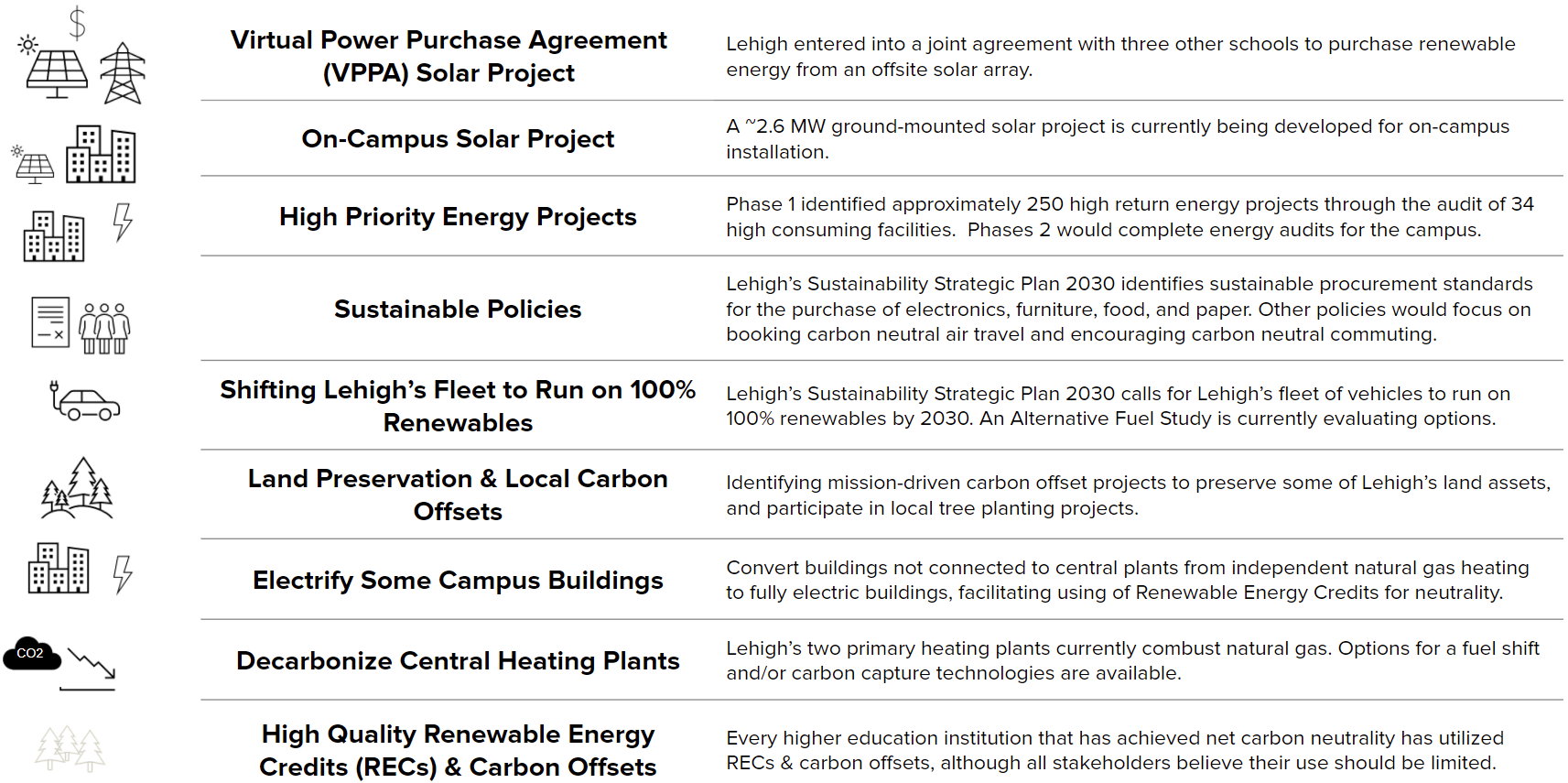Nine Emissions Reduction Strategies
A combination of nine major emissions reduction strategies have been identified as the ‘Pathway to Zero’ emissions for Lehigh to achieve net carbon neutrality by 2040. These strategies (see Figure 1) are listed in order from most fully developed for implementation to least developed. It is important to note that although these have been defined as part of the strategy, Lehigh understands that technology and other factors may change over the next 19 years and will adapt accordingly.
Implementation of some of the projects listed in Figure 1 have already begun while others will begin in FY 22. They will occur in phases upon release of the strategy. Lehigh anticipates achieving a 60% reduction in net emissions by 2025 as compared to Lehigh’s base year for GHG emissions, CY 2007. The initial reduction in emissions will primarily be realized through the VPPA solar project (38% emissions reduction), on-site solar project (4% emission reduction) and high priority energy projects (10% emissions reduction). Other CAS initiatives, such as implementing sustainable purchasing policies and planning for the decarbonizing of central heating plants, will also begin by 2025 and contribute to GHG reductions. By 2030, all CAS initiatives, except the purchase of RECs and carbon offsets, will be underway. Lehigh anticipates achieving an 80% reduction in net emissions by 2030 and will continue to improve upon emissions reductions between 2030 and 2040.

Projected GHG Emissions Through 2040
Figure 2 shows Lehigh’s projected emissions from 2022 to 2040 as well as the impact of each emissions reduction strategy and GHG reduction targets for 2025, 2030 and 2040.
Throughout the 2022 to 2040 period of assessment, climate action strategies will require new capital investments that will reduce GHG emissions and operating costs.
This strategy incorporates both existing capital plan costs and incremental new investments. Existing capital plan costs represent the capital requirements necessary to continue campus operations as they currently exist. Incremental new investments represent additional capital requirements beyond the existing capital plan to implement sustainable solutions.
Strategies & Incremental New Investments
In total, it is estimated that $12-$26 million (using 2021 dollars) in incremental new investments will be required through 2040 to reach net carbon neutrality. However, the additional $12-$26 million will not be distributed as a single-lump sum. The new investments have been planned in a way that allows for operational savings to reduce the total amount of capital required for implementation. Figure 3 summarizes recommended emissions reduction strategies and highlights the portion of capital that represents incremental new investments.
Estimated Paybck for New Investments
Through the 2022-2040 assessment period, it is estimated that CAS initiatives will produce a total of over $29 million in operational savings on campus. Each CAS initiative was examined independently to understand the yearly and total savings resulting from each incremental new investment as well as present value savings. Figure 4 shows aggregated cumulative life cycle cost impacts of new CAS investments.
Of all the emissions reduction strategies required to achieve net carbon neutrality, the high priority energy projects provide the most significant operational savings and begin generating savings early in the 2022 to 2040 time period. Implementation of Phase 1 of the high priority energy projects will require approximately $3 million of investment and includes an allocation to complete energy audits of remaining campus facilities. With approximately $375,000 in annual energy savings, plus a one-time rebate of $250,000, these Phase 1 projects have a simple payback period of 6.6 years with an ROI of 15%. Completion of energy audits for all of Lehigh’s facilities will allow Phase 2 to be implemented by 2025. Through the 2022 to 2040 period, implementation of all high priority energy projects will save a total of $14.7 million, after investments, and will provide a life cycle present value savings of $6.8 million.
